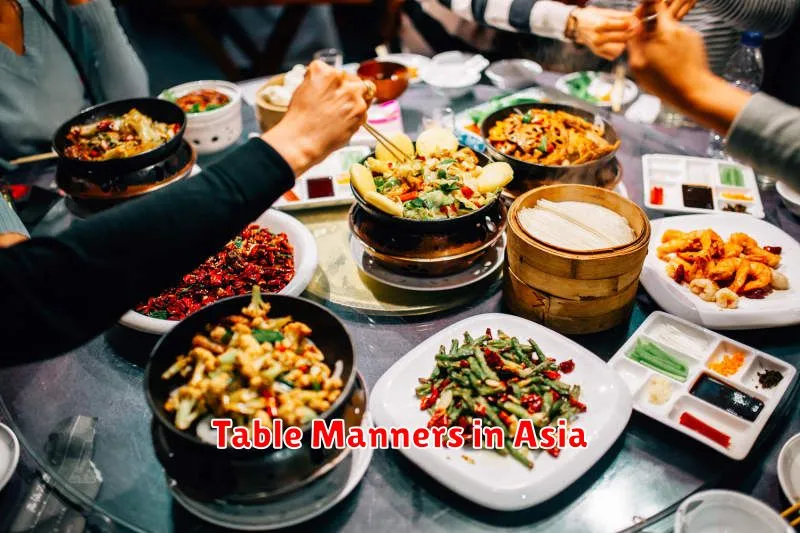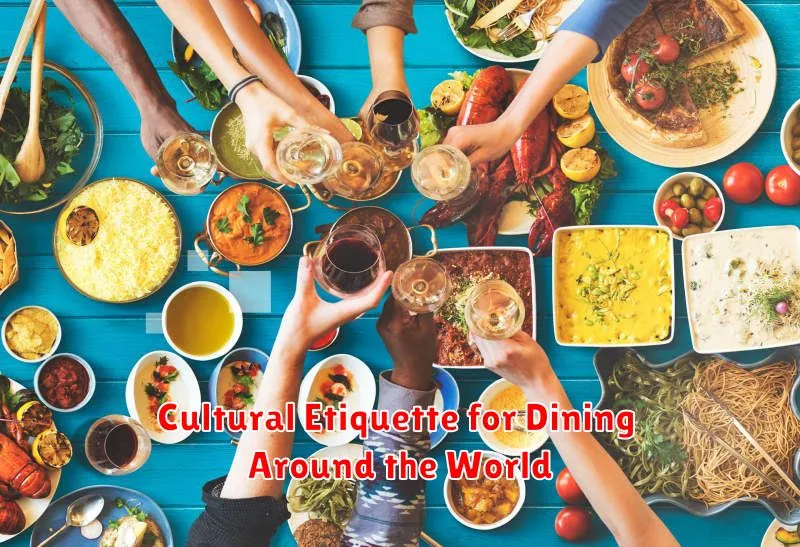Embark on a culinary journey around the globe with our comprehensive guide to cultural etiquette for dining. Understanding dining etiquette is crucial for navigating diverse cultural landscapes, whether for business, leisure, or personal enrichment. From the proper use of chopsticks in Japan to the art of the “no elbows on the table” rule in Western cultures, this guide will equip you with the cultural knowledge to dine gracefully and respectfully around the world. Learn how to avoid common faux pas and embrace the nuances of different dining customs to make a positive impression and truly appreciate the richness of global culinary experiences.
Discover the fascinating intricacies of table manners across continents, including specific cultural etiquette tips for dining in various countries. Whether you are curious about proper greetings, tipping practices, or appropriate conversation topics, this guide will provide invaluable insights into dining etiquette around the world. Explore the cultural norms surrounding food preparation, serving styles, and even the proper way to decline a dish. By mastering these cultural dining nuances, you can confidently navigate social situations, foster meaningful connections, and savor the full spectrum of international culinary traditions.
Why Dining Etiquette Is Important
Dining etiquette is more than just knowing which fork to use. It’s about showing respect for your fellow diners, the host, and the dining establishment itself. Proper etiquette creates a positive and comfortable atmosphere for everyone. It demonstrates consideration and helps to facilitate smooth and pleasant interactions throughout the meal. By adhering to basic dining etiquette, you avoid inadvertently causing discomfort or offense to others.
Beyond personal comfort, dining etiquette plays a significant role in professional settings. A grasp of proper table manners can convey professionalism and polish, which can be crucial during business lunches, dinners, or networking events. Understanding the nuances of dining etiquette can help you make a positive impression and build stronger relationships with colleagues and clients. This can, in turn, positively impact your career advancement and opportunities.
In essence, dining etiquette contributes to a more enjoyable and respectful dining experience for everyone involved. Whether it’s a casual meal with friends or a formal business dinner, understanding and practicing proper etiquette is a valuable social skill that enhances social interactions and leaves a lasting positive impression.
Table Manners in Asia

Asian dining customs are diverse, reflecting the rich tapestry of cultures across the continent. However, some common threads weave through many traditions. Respect is a cornerstone of Asian table manners, demonstrated through gestures like waiting for elders to begin eating, using both hands to offer or receive food, and avoiding talking with your mouth full. Sharing is also a key element, with dishes often served family-style in the center of the table. It is considered polite to try a little bit of everything offered, and to avoid taking the last portion of a shared dish without offering it to others first.
Chopstick etiquette is an important aspect of dining in many East and Southeast Asian countries. Avoid sticking chopsticks upright in a bowl of rice, as this resembles incense offerings used in funerals. It’s also considered rude to point with your chopsticks or use them to pass food directly to someone else. In some cultures, like Japan, it’s acceptable to lift small bowls to your mouth when eating rice or soup. However, in other cultures, like Korea, this might be seen as impolite. When finished eating, place your chopsticks neatly on a chopstick rest or alongside your bowl.
Specific customs may vary significantly from country to country. In some cultures, slurping noodles is a sign of appreciation for the meal. In others, burping is considered a compliment to the chef. If you are unsure about the proper etiquette, it’s always best to observe your host and follow their lead. Demonstrating a willingness to learn and adapt to local customs will always be appreciated.
What Not to Do in Europe
Europe offers a rich tapestry of cultures, each with its own unique customs and etiquette. Being mindful of these differences is key to a smooth and enjoyable trip. Avoid assuming everyone speaks English. While English is widely spoken, particularly in tourist areas, learning a few basic phrases in the local language is a sign of respect and can greatly enhance your interactions. Also, be aware of personal space. Europeans tend to stand closer together than North Americans, particularly in Southern Europe. Don’t back away or appear uncomfortable, as this can be seen as rude.
Navigating public transportation requires a bit of awareness. Avoid blocking doorways, especially during rush hour. Validate your tickets when necessary, as fines for riding without a validated ticket can be steep. Be mindful of noise levels, particularly on trains and buses. Loud conversations or music can disturb fellow passengers. Furthermore, tipping customs vary greatly across Europe. Researching tipping practices in your destination country beforehand will prevent both under-tipping and over-tipping.
Finally, be patient. Things may not always move at the same pace as they do at home. Embrace the slower pace of life and enjoy the experience. Avoid making stereotypical assumptions about European cultures. Europe is a diverse continent, and generalizations often miss the mark. Treat every interaction as a learning opportunity and be open to new experiences.
Tipping Customs by Country

Tipping customs vary significantly around the world. In some countries, tipping is deeply ingrained in the culture and considered essential, while in others it is less common or even viewed negatively. Understanding these nuances can help travelers avoid awkward situations and ensure they show appropriate appreciation for services rendered. Researching tipping customs before traveling to a new country is highly recommended.
Many factors influence tipping practices, including cultural norms, local wages, and the type of service provided. For example, in the United States, tipping is expected for services like restaurant dining, taxi rides, and hotel housekeeping. The typical amount varies, but 15-20% for restaurants and $1-2 per bag for bellhops are common. Conversely, in Japan, tipping is often considered rude and can be misinterpreted as an insult. Other countries, like Australia and many in Europe, have less rigid tipping customs where it is appreciated but not always mandatory.
Beyond the customary amounts, it’s also essential to be mindful of the method of tipping. In some cultures, it’s customary to add the tip to the bill when paying by card, while in others, cash is preferred. Additionally, some countries have implemented service charges that may replace or supplement traditional tipping. Be aware of local practices and feel free to ask for clarification if needed.
Religious Customs in Meal Settings
Religious customs often play a significant role in how meals are prepared, served, and consumed. These customs can vary widely, encompassing everything from dietary restrictions and fasting practices to specific prayers or blessings before and after meals. Understanding these customs is crucial for demonstrating respect and sensitivity when sharing a meal with individuals from different religious backgrounds. Some common examples include abstaining from certain foods like pork in Islam and Judaism, observing vegetarianism in some sects of Hinduism and Buddhism, and refraining from alcohol in many faiths.
Beyond dietary laws, religious customs can also dictate the manner in which food is handled and eaten. For instance, some religions may require ritual handwashing before meals, the use of specific utensils, or seating arrangements that reflect hierarchical structures within the community. Grace, or a prayer of thanks, is often recited before or after a meal in many Christian denominations. In some cultures, sharing food is a significant act of communion and fellowship, strengthening social bonds within the religious community.
It’s important to note that within any given religion, there can be variations in customs based on individual interpretations, cultural influences, or specific denominations. If you are unsure about appropriate etiquette, it is always polite and respectful to inquire beforehand. Demonstrating an interest in and respect for the customs of others fosters understanding and creates a more welcoming and inclusive dining experience.
Invitations and Hosting Etiquette
Invitations should be sent out well in advance of the event, allowing guests ample time to RSVP. Clearly state the date, time, location, and dress code. For formal events, a written invitation is preferred, while informal gatherings may utilize digital methods like email or text. Be sure to include any special instructions, such as dietary restrictions or gift preferences.
As a host, your primary goal is to make your guests feel welcome and comfortable. Greet each guest upon arrival, offer refreshments, and facilitate introductions as needed. Engage in conversation and create a pleasant atmosphere. Keep an eye on your guests’ needs, ensuring they have everything they require, from drinks to comfortable seating. A gracious host anticipates their guests’ needs before being asked.
When attending an event, proper guest etiquette dictates responding to the invitation promptly. Arrive on time, or within the acceptable window for the type of event. Bring a hostess gift, especially for dinner parties or overnight stays. Engage politely with other guests and offer to help the host when appropriate. Thank the host before leaving and follow up with a thank-you note or email expressing your gratitude for their hospitality.
Learning Before You Eat
Food safety is paramount for maintaining good health. Understanding potential risks associated with food preparation and consumption can prevent foodborne illnesses. Key areas to focus on include proper handwashing techniques, safe food storage practices (refrigeration and freezing), and thorough cooking to eliminate harmful bacteria. By being mindful of these practices, you significantly reduce your risk of illness.
Education is key to safe food handling. Seek out reliable resources like government health websites or university extension programs for comprehensive information. These resources often provide specific guidelines for handling different types of food, including meat, poultry, seafood, and produce. Understanding proper thawing methods, internal cooking temperatures, and the dangers of cross-contamination are essential aspects of food safety.
Taking proactive steps before you eat, such as inspecting food for spoilage and practicing good hygiene, contributes significantly to your well-being. Remember, a small investment in learning about food safety can pay huge dividends in preventing illness and promoting long-term health.

